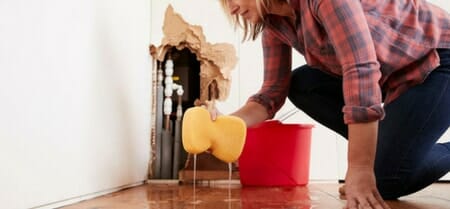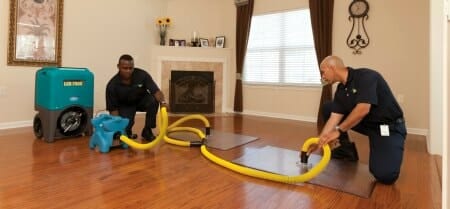How to Fix a Laminate Floor That Got Wet
Laminate flooring: it's affordable, durable, and attractive.
Best of all, it's designed to withstand the occasional spill . What happens, though, when that spill becomes a deluge? If you've recently experienced water damage to your laminate floors, you're probably wondering how to repair swollen laminate flooring.
When laminate gets saturated with liquid, the planks will buckle, bend, or give under weight . This can be a dangerous and unpleasant situation, and fixing the laminate wood floor water damage quickly is essential.
Luckily, in some cases repairing your laminate floors after water damage can be a DIY job.

Repair Laminate Flooring Water Damage with These Steps
Regardless of whether you have major or minor water damage, these six steps will help you contain and repair damage and get your floors back to normal:
1. Stop the Leak

What's the first step in learning how to fix a laminate floor that got wet?
It's simple:
Stop it from becoming any wetter.
It's impossible to fix the damage unless you stop the leak, first. With this in mind, the first step of repair is to locate the source of the water . While there are many causes of flooding when it comes to laminate flooring, faulty appliances ( leaking dishwashers are a prime culprit), leaking toilets, and burst pipes are a few of the most common.
If you can't find the leak easily on your own, contact a local contractor or a water damage contractor to help you find it.
2. Determine How Much Laminate Needs Repair
The next thing you'll have to do is determine how extensive the flooding was, and how much laminate flooring you must repair.
Take a moment to evaluate your laminate flooring in each room. Note boards that are bubbled or warped, and boards that don't fit together evenly. Mark damaged areas with a colored piece of tape or sticky note.
3. Remove Damaged Planks
Next, it's time to remove the damaged planks and get to work fixing the areas that need it.
Before you begin this portion of the project, be sure you have all the tools you'll need. As a general rule, you'll need a hammer and a crowbar at the very least, although a utility knife will also come in handy.
Never removed laminate planks before? Here's a video to walk you through it:
4. Replace Damaged Planks
Once you've removed the damaged planks from the affected area, you'll need to replace them with fresh planks.
While this is a very approachable DIY project, many people find it intimidating, since it can be difficult to match new laminate planks with the laminate planks you already have.
Because of this, this portion of the project will be easier if you have planks left over from when you first installed your floor.
If you don't have any extra planks, head to your local home store to find planks that match your current planks as closely as possible. A slight variation won't make a large difference once the planks are installed.
Once you've found the replacement planks, fit them with your current planks, taking care to avoid nails and other hazards that may have been exposed when you removed the existing laminate flooring.
Need Help with Laminate Floor Water Damage in Chicago? We Can Help

In some cases, your laminate floors will be too damaged to repair them on your own. In these cases, you'll want to contact a professional to help.
Even if you do plan to DIY your floors, it's always wise to consult with a professional about your laminate flooring repairs. Doing so can help ensure you avoid common problems and wind up with the most beautiful floor possible.
Do you need water damage cleanup services in the Chicago, Illinois area ? Contact the team at ServiceMaster by Zaba now: 773-647-1985
How long does it take for water to damage laminate flooring?
Most laminate floors can hold up under water for two or three hours. Flooring professionals recommend replacing laminate flooring that's been submerged for four or more hours.
Can water under a laminate floor cause mold?
Yes. Laminate contains wood fibers, and mold feeds on this natural material. If not properly addressed during replacement, mold can spread and damage the new flooring.
Do I have to replace the subfloor under a water-damaged laminate floor?
It depends on the extent of the damage. As you pull up wet laminate, peel back the underlayment. Carefully inspect the subfloor. If you suspect problems, bring in a restoration professional.
How to Fix a Laminate Floor That Got Wet
Source: https://www.servicemasterbyzaba.com/blog/laminate-flooring-water-damage/